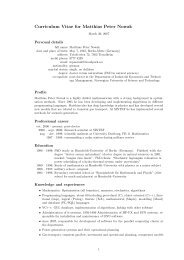Exam in TIØ4317 – Empiriske og kvantitative metoder i finans, 2009
Exam in TIØ4317 – Empiriske og kvantitative metoder i finans, 2009
Exam in TIØ4317 – Empiriske og kvantitative metoder i finans, 2009
You also want an ePaper? Increase the reach of your titles
YUMPU automatically turns print PDFs into web optimized ePapers that Google loves.
Norges teknisk-naturvitenskapelige universitet<br />
Institutt for <strong>in</strong>dustriell økonomi <strong>og</strong> teknol<strong>og</strong>iledelse<br />
Contacts dur<strong>in</strong>g exam:<br />
1. Alexei Gaivoronski, tlf: 48243742<br />
2. Sjur Westgaard, tlf. 97122019<br />
Sensurer<strong>in</strong>gsfrist: 05.06.<strong>2009</strong><br />
<strong>Exam</strong> <strong>in</strong> <strong>TIØ4317</strong> <strong>–</strong> <strong>Empiriske</strong> <strong>og</strong> <strong>kvantitative</strong><br />
<strong>metoder</strong> i f<strong>in</strong>ans, <strong>2009</strong><br />
All types of calculators are admitted to exam<br />
Exercise 1<br />
Portfolio manager of pension fund Trygg Havn have to make decision about<br />
distribution of funds wealth between two classes of assets. One is governmental bonds<br />
which give 6% yearly return and are considered to be risk free. Another is <strong>in</strong>dex fund<br />
which follows the overall <strong>in</strong>dex of Rosenborg Stock Exchange. Dur<strong>in</strong>g the last 200<br />
trad<strong>in</strong>g days this <strong>in</strong>dex has shown the follow<strong>in</strong>g daily returns:<br />
return -5% -4% -3% -2% -1% 0% 1% 2% 3%<br />
Number of 3 7 9 15 22 38 72 29 5<br />
days<br />
The pension fund manager uses these data as the empirical distribution of future<br />
returns of the <strong>in</strong>dex. In order to serve his liabilities the manager has to construct<br />
portfolio with at least 8% yearly return.<br />
At the same time <strong>in</strong> order to fulfill requirements of regulatory bodies the daily 95%<br />
VaR of his portfolio should not exceed 1%.<br />
1. Is it possible for manager to reach both return and risk targets?<br />
2. What will be the answer if 1% risk bound is expressed <strong>in</strong> CVaR <strong>in</strong>stead of VaR?<br />
Please give detailed answer.<br />
Exercise 2<br />
Portfolio revision when the assets can be bought and sold <strong>in</strong> lots.<br />
There are many types of assets that can be bought and sold only <strong>in</strong> fixed amounts<br />
called lots. You are <strong>in</strong>vited to formulate portfolio rebalanc<strong>in</strong>g problem similar to<br />
those described <strong>in</strong> the book of Zenios, chapter 3, when portfolio is composed from<br />
such assets. Let us denote:<br />
yi <strong>–</strong> current hold<strong>in</strong>g of asset i, i=1:n<br />
p0i <strong>–</strong> current price of one unit of asset i<br />
pi - random future price of one unit of asset i<br />
These assets can be bought and sold <strong>in</strong> fixed lots of two sizes: smaller lot of asset i<br />
consists of k1i units and larger lot consists of k2i units. Buy<strong>in</strong>g or sell<strong>in</strong>g of one smaller<br />
lot entails transaction cost c1i. Buy<strong>in</strong>g or sell<strong>in</strong>g of one larger lot entails transaction<br />
cost c2i.<br />
1
1. Please formulate portfolio revision model with these assets<br />
2. Discuss its properties and possibilities for implementation.<br />
Exercise 3<br />
In this analysis we study credit spreads <strong>in</strong> the UK bond market. That is the difference<br />
between long term yields on corporate AAA rated bonds and government bonds. We<br />
have run an ADF test and confirmed that the spread is stationary. Then we model the<br />
credit spread with 2 ARMA models:<br />
• ARMA(2,2)<br />
• ARMA(2,0)<br />
The results from these 2 models t<strong>og</strong>ether with residual diagnostics are given below:.<br />
2
a) Write down the two models with their parameters. Give comments to the<br />
parameter values and their significance. Test formally if the MA(1) term and<br />
the MA(2) term <strong>in</strong> the ARMA(2,2) are significant. Choose a significance<br />
level at 5%.<br />
b) Describe and perform a test for normality and serial-correlation of the<br />
residuals for the two models. How are the results compare the assumptions we<br />
usually apply to l<strong>in</strong>ear regression models and ARMA models?<br />
c) Describe a criterion for model selection that can be applied. Accord<strong>in</strong>g to this<br />
criterion, which model will you choose?<br />
Exercise 4<br />
In this exercise we analyze volatility <strong>in</strong> the FX market. We are look<strong>in</strong>g at daily returns<br />
for USDJPY <strong>in</strong> the period 7/11 1984 to 31/8 2007. We estimate a GARCH(1,1)<br />
model, a GJR(1,1) model and an EGARCH(1,1) model for the volatility equation. For<br />
the mean equation we just assume a constant. The results for the models are given<br />
below:<br />
4
a) Write down the different models with their parameter estimates and <strong>in</strong>tepret<br />
the models. Give comments to the parameter significance. What type of<br />
restrictions should be apply to the parameters?<br />
b) Calculate the unconditional variance and standard-deviation for the<br />
GARCH(1,1) model.<br />
c) Discuss if asymmetry <strong>in</strong> volatility should be modeled for USDJPY.<br />
5






